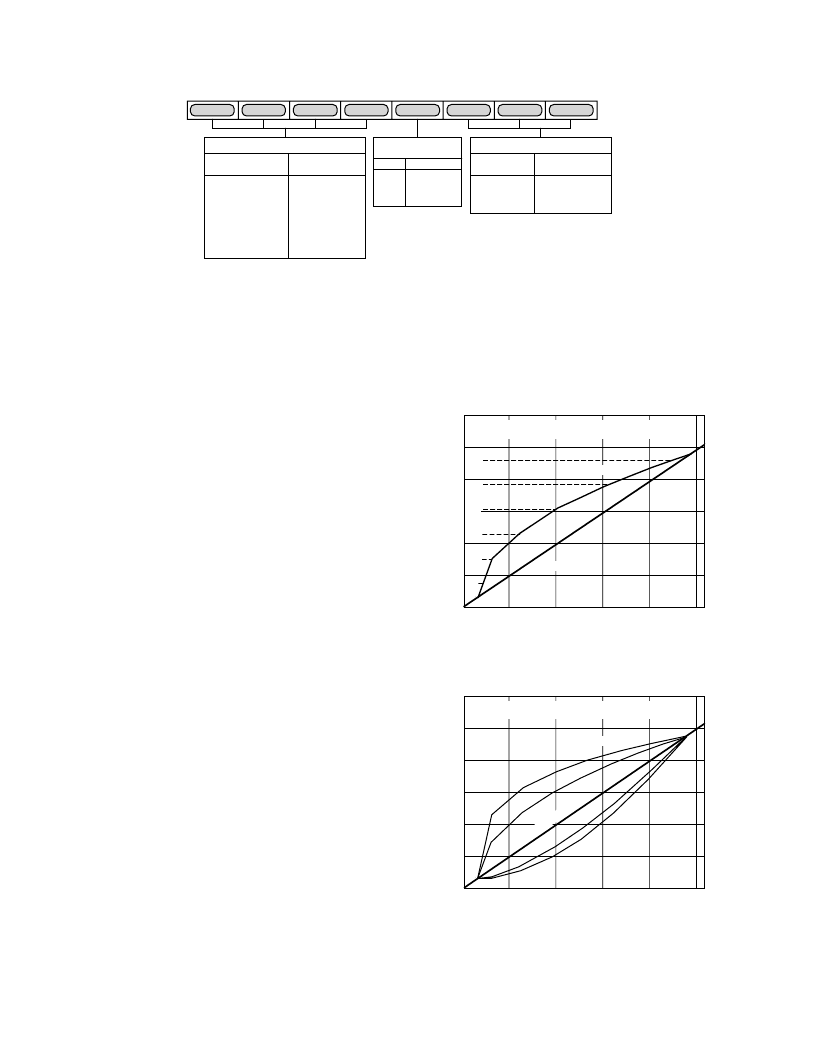- 您現(xiàn)在的位置:買賣IC網(wǎng) > PDF目錄374047 > ADV7191 (Analog Devices, Inc.) Video Encoder with Six 10-Bit DACs and Video Encoder with Six DAC Outputs PDF資料下載
參數(shù)資料
| 型號: | ADV7191 |
| 廠商: | Analog Devices, Inc. |
| 英文描述: | Video Encoder with Six 10-Bit DACs and Video Encoder with Six DAC Outputs |
| 中文描述: | 視頻編碼器與六10位DAC和DAC的輸出6視頻編碼器 |
| 文件頁數(shù): | 42/69頁 |
| 文件大?。?/td> | 628K |
| 代理商: | ADV7191 |
第1頁第2頁第3頁第4頁第5頁第6頁第7頁第8頁第9頁第10頁第11頁第12頁第13頁第14頁第15頁第16頁第17頁第18頁第19頁第20頁第21頁第22頁第23頁第24頁第25頁第26頁第27頁第28頁第29頁第30頁第31頁第32頁第33頁第34頁第35頁第36頁第37頁第38頁第39頁第40頁第41頁當(dāng)前第42頁第43頁第44頁第45頁第46頁第47頁第48頁第49頁第50頁第51頁第52頁第53頁第54頁第55頁第56頁第57頁第58頁第59頁第60頁第61頁第62頁第63頁第64頁第65頁第66頁第67頁第68頁第69頁

ADV7190/ADV7191
–42–
REV. 0
GAMMA CORRECTION REGISTERS 0–13
(GAMMA CORRECTION 0–13)
(Address (SR5–SR0) = 26H–32H)
The Gamma Correction Registers are fourteen 8-bit-wide regis-
ters. They are used to program the gamma correction Curves A
and B.
Gamma correction is applied to compensate for the nonlinear
relationship between signal input and brightness level output (as
perceived on the CRT). It can also be applied wherever nonlin-
ear processing is used.
Gamma correction uses the function:
Signal
OUT
= (Si
gnal
IN
)
γ
where
γ
= g
amma power factor
Gamma correction is performed on the luma data only. The
user has the choice to use two different curves, Curve A, or
Curve B. At any one time only one of these curves can be used.
The response of the curve is programmed at seven prede
fi
ned
locations. In changing the values at these locations the gamma
curve can be modi
fi
ed. Between these points linear interpolation
is used to generate intermediate values. Considering the curve
to have a total length of 256 points, the seven locations are at:
32, 64, 96, 128, 160, 192, and 224.
Values at Location 0, 16, 240, and 255 are
fi
xed and cannot be
changed.
For the length of 16 to 240 the gamma correction curve has to
be calculated as below:
y
= x
γ
where
y
= gamma corrected output
x
= linear input signal
γ
= gamma power factor
To program the gamma correction registers, the seven values for
y
have to be calculated using the following formula:
y
n
= [
x
(
n–
16)
/(240
–
16) ]
γ
×
(240
–
16) + 16
where
x
(
n-
16) =
Value for x along x-axis
y
n
into the gamma correction register
n
= 32, 64, 96, 128, 160, 192, or 224
Example:
y
32
= [(16/224)
0
.5
×
224] + 16
=
76
*
y
64
= [(48/224)
0
.5
×
224] + 16 =120
*
=
Value for y along the y-axis, which has to be written
y
96
= [(80/224)
0
.5
×
224] + 16 = 150
*
y
128
= [(112/224)
0
.5
×
224] + 16 = 174
*
*
Rounded to the nearest integer.
The above will result in a gamma curve shown below, assuming
a ramp signal as an input.
250
200
150
100
50
0
300
250
200
150
100
50
300
SIGNAL OUTPUT
SIGNAL INPUT
0.5
GAMMA CORRECTION BLOCK OUTPUT
TO A RAMP INPUT
G
–
C
0
50
100
150
200
250
LOCATION
Figure 85. Signal Input (Ramp) and Signal Output for
Gamma 0.5
250
200
150
100
50
0
300
SIGNAL OUTPUTS
SGNALINPUT
0.5
GAMMA CORRECTION BLOCK OUTPUT
TO A RAMP INPUT FOR VARIOUS GAMMA VALUES
G
–
C
0
50
100
150
200
250
LOCATION
0.3
1.5
1.8
Figure 86. Signal Input (Ramp) and Selectable Gamma
Output Curves
The gamma curves shown above are examples only, any user-
de
fi
ned curve is acceptable in the range of 16
–
240.
DNR27
DNR26
DNR25
DNR24
DNR23
DNR22
DNR21
DNR20
BLOCK OFFSET
DNR DNR DNR DNR
27 26 25 24
0
0
0
0
0
0
1
1
1
1
1
1
0
0
1
0
1
1
0
1
0
1
0
1
0 PIXEL OFFSET
1 PIXEL OFFSET
2 PIXEL OFFSET
13 PIXEL OFFSET
14 PIXEL OFFSET
15 PIXEL OFFSET
DNR INPUT SELECT
DNR DNR DNR
22 21 20
0
0
0
1
0
1
1
0
1
0
1
0
FILTER A
FILTER B
FILTER C
FILTER D
0
1
DNR MODE
DNR
SHARPNESS
MODE
DNR23
DNR MODE
CONTROL
Figure 84. DNR Register 2
相關(guān)PDF資料 |
PDF描述 |
|---|---|
| ADV7191KST | Video Encoder with Six 10-Bit DACs and Video Encoder with Six DAC Outputs |
| ADV7190 | Video Encoder with Six 10-Bit DACs and Video Encoder with Six DAC Outputs |
| ADV7192KST | Video Encoder with Six 10-Bit DACs, 54 MHz Oversampling and Progressive Scan Inputs |
| ADV7192 | Video Encoder with Six 10-Bit DACs, 54 MHz Oversampling and Progressive Scan Inputs |
| ADV7194KST | Professional Extended-10⑩ Video Encoder with 54 MHz Oversampling |
相關(guān)代理商/技術(shù)參數(shù) |
參數(shù)描述 |
|---|---|
| ADV7191KST | 制造商:Analog Devices 功能描述:Video Encoder 6DAC 10-Bit 64-Pin LQFP 制造商:Rochester Electronics LLC 功能描述:54M 4X STD DEF ENCODER NON-MACRO I.C. - Tape and Reel |
| ADV7191KSTZ | 制造商:Analog Devices 功能描述:Video Encoder 6DAC 10-Bit 64-Pin LQFP 制造商:Analog Devices 功能描述:IC VIDEO ENCODER |
| ADV7192 | 制造商:AD 制造商全稱:Analog Devices 功能描述:Video Encoder with Six 10-Bit DACs, 54 MHz Oversampling and Progressive Scan Inputs |
| ADV7192KST | 制造商:AD 制造商全稱:Analog Devices 功能描述:Video Encoder with Six 10-Bit DACs, 54 MHz Oversampling and Progressive Scan Inputs |
| ADV7194 | 制造商:AD 制造商全稱:Analog Devices 功能描述:Professional Extended-10⑩ Video Encoder with 54 MHz Oversampling |
發(fā)布緊急采購,3分鐘左右您將得到回復(fù)。